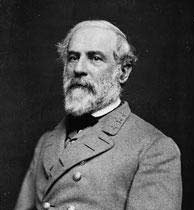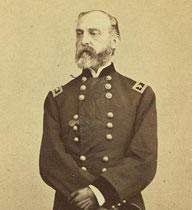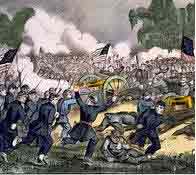Welcome to THE MAKING OF A NATION – American history in VOA Special English.
America's civil war in the 1860s did not have the full support of the people. Many said they did not care who won -- North or South. They just wanted to be left alone.

In the North, many young men refused to be drafted into the Union army. Some of their protests turned violent.
Southern leaders were pleased with the anti-war movement in the North. Confederate General Robert E. Lee saw it as a sign of weakness in the northern war effort. He also saw it as an opening for a military victory. Lee hoped for a final, decisive blow that would bring the war to an end.
This week in our series, Kay Gallant and Harry Monroe talk about General Lee's campaign north to Gettysburg, Pennsylvania.
VOICE ONE:
Gettysburg was a small town. Many roads came together there. Robert E. Lee needed those roads to pull his army together quickly. He had 70,000 men in all. But they were spread over a wide area of southern Pennsylvania.
Some were at York, to the east. Some were at Carlisle, to the north. And most were at Chambersburg, to the west. All of them were ordered to move against the Union force at Gettysburg.
General Robert E. Lee had not planned to go to Gettysburg. He had planned to capture Harrisburg, the state capital, and then Philadelphia. If successful, he would turn south to seize Baltimore and Washington.
Lee had not worried about the large Union Army of the Potomac. He believed it was far behind him, in Virginia. But Lee was wrong. The Union Army had followed him. And it had reached Gettysburg first.
VOICE TWO:
The first group of northern soldiers formed a thin line of defense outside Gettysburg. The first group of southern soldiers attacked this line. It was the morning of July 1st, 1863.
When the guns began to roar, both sides hurried more men to the front.
After hours of fighting, the Confederates had pushed the Union soldiers back through the town. The Union soldiers formed a new line along a place called Cemetery Hill.
General Robert E. Lee decided not to attack the hill immediately. He would wait for more men. But as he waited, more and more Union soldiers arrived. By sunrise the next day, Lee's 70,000 men faced a Union army of 90,000 men.
VOICE ONE:

The Confederates attacked both sides of the Union line. They moved the Union soldiers a little. But then the Union soldiers came back again. The Confederates could not hold the line.
The fighting stopped at sunset. Union commander George Meade met with his generals. He said he was sure General Lee would attack again the next day. The next attack, Meade said, would be against the center of the Union line.
Meade was right. Lee planned to send 15,000 men against the Union center. They would be under the command of General George Pickett.
(MUSIC)
VOICE TWO:

When the sun rose on July 3rd, the Union troops were ready. They watched as the Confederate troops set up their cannon. More than 130 of these big guns were aimed at the center of the Union line.
The morning passed. The day grew hotter. A little past one o'clock in the afternoon, a Confederate gun fired, once. Then again. That was the signal to attack.
All at once, the Confederate artillery thundered with a deafening roar. The cannon sent iron and smoke into the Union soldiers on Cemetery Hill. Within minutes, hundreds lay dead or dying.
Union artillery on the hill answered the Confederate cannon. Men lay flat on the ground. They prayed for the shelling to stop. Finally, it did. And the smoke of battle began to clear.
VOICE ONE:
Now the Union soldiers could see across the valley. They watched as the Confederate soldiers formed a long line. It was a sight to take your breath away.
Facing Cemetery Hill, the Confederates stood shoulder to shoulder in a line almost two kilometers long. Sunlight shone from their guns. Their battle flags waved. Slowly, the line began to move. It seemed more like a parade than an attack.
Shouts went up and down the Union line. "Here they come! Here come the rebels!"
(MUSIC)
VOICE TWO:

Thousands of Confederate soldiers moved across the valley outside Gettysburg. Union artillery opened fire. The guns tore open big holes in the Confederate battle line. But the southerners kept moving forward up the hill.
Union soldiers rose up from behind stone walls and fallen trees. They poured even more gunfire into the Confederate line. More and more bodies fell to the ground. Still, the line moved forward.
A few Confederates reached the Union line, but not enough to seize it. They were shot down. Suddenly, the Confederates began racing down the hill. Many raised their hands in surrender. 15,000 began the attack. Only half returned.
The battle of Gettysburg was over.
The Union commander, General Meade, was told that the Confederate attack had been broken. He said, simply: "Thank God." The Confederate commander, General Lee, said: "This has been a sad day for us, a sad day."
VOICE ONE:
Lee's invasion of the North had failed. There was only one thing he could do now: retreat. He must get his army back to Virginia. He could only hope that the Union Army was hurt too badly to chase him.
The line of wagons carrying wounded soldiers was 25 kilometers long. Many of the wounded needed treatment. But the wagons were not permitted to stop for any reason.
Suffering was terrible. An officer who led the wagon train said he learned more about the horrors of war on that one trip than he had learned in all of his battles.
20,000 Confederate soldiers were killed, wounded, or listed as missing in the battle of Gettysburg. 23,000 Union soldiers were killed, wounded or missing.
VOICE TWO:
General Meade lost so many men that he was in no hurry to chase General Lee. He believed it might be best to let Lee escape than to take a chance on losing what remained of the Army of the Potomac.
Meade waited for a week until his army was stronger. But by then, Lee and his men had crossed safely back into Virginia.
President Abraham Lincoln was angry. He had told General Meade that driving the Confederates out of the North was not enough. The southern army must be destroyed.
"We had them," Lincoln said. "We had only to stretch out our hands and take them. And nothing I could do or say could make the army move."
VOICE ONE:
President Lincoln believed that General Meade had made a mistake. But he felt that the general had ability. Lincoln was thankful for what Meade had done at Gettysburg. He said Meade would continue to command the Army of the Potomac.
In November of 1863, President Lincoln went to Gettysburg. He attended the opening of a new burial place for the Union soldiers who had died in the great battle there.
VOICE TWO:
The governor of Pennsylvania had asked the president to say a few words at the ceremony. Lincoln agreed. He felt it was his duty to go to honor the brave men who lost their lives to save the Union. Lincoln hoped his words might help lift the spirit of the nation.
Lincoln did not have much time to prepare his speech. He wrote it down the night before the ceremony. Lincoln was sure the speech was not a good one. But it came to be one of the most famous speeches in American history.
We will tell the story of Abraham Lincoln's Gettysburg Address next week.
(MUSIC)
ANNOUNCER:
Our program was written by Frank Beardsley. The narrators were Kay Gallant and Harry Monroe. Transcripts, MP3s and podcasts of our programs are online, along with historical images, at voaspecialenglish.com. And you can follow our weekly programs on Twitter at VOA Learning English. Join us again next week for THE MAKING OF A NATION -- an American history series in VOA Special English.
Related stories:
American history series: Lee and his army cross into the North
The South wins a battle, but loses Stonewall Jackson
American history series: at Bull Run, a terrible defeat for the North
American history series: South defends its capital
American history series: the Civil War at sea
Lincoln names a general to defend Washington
American history series: the North loses the first major battle of the war
American history series: the Civil War's first days
(Source: VOA 英语点津编辑)